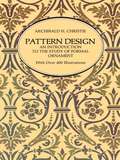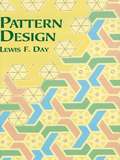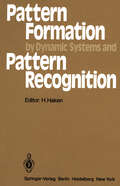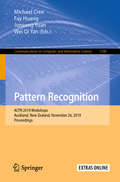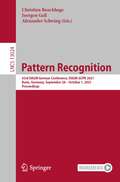- Table View
- List View
Pattern Design: An Introduction to the Study of Formal Ornament
by Archibald H. ChristieApproaching the study of design from a structural point of view, this classic handbook tells the designer how to construct hundreds of patterns from all periods and styles. Dr. Christie analyzes the elemental composition of patterns, and shows how coherent organization is achieved in each of the patterns he describes and illustrates. He then establishes basic principles, derived from the unity of all great ornament, which, if followed, will assure the success of any design.In the opening chapters the author describes various basic methods of organizing ornament, and explains the formal classification of ornament into distinct categories. He covers the six major categories of design separately, showing how numerous variations are made: traditional plant and animal devices; realistic plants and animals; straight striped patterns; waved and chevron striped patterns; cross-band patterns; and interlaced and counterchanged cross-band patterns. In another chapter he shows how some isolated devices of formal design -- granular texturings, disk and ring devices, arabesques, and more -- are constructed. He shows how design is created by rhythmic expansion -- how an element like a spiral or a swastika, for example, can be expanded in horizontal, vertical, and diagonal progressions to create the rhythmic scheme that constitutes a formal design.The book contains more than 400 illustrations, including the author's drawing of designs as well as photographs of actual patterns in textiles, ceramics, jewelry, and more -- a wealth of valuable pictorial material that is not readily available. As a unified discussion of the nature of patterns, this book will be of great interest to anyone concerned with handicrafts or the fine arts.
Pattern Design
by Lewis F. DayTake any form you choose and repeat it at regular intervals, and, just as repetitive sounds produce rhythm or cadence, you have pattern. However, the use of pattern in design is no haphazard matter, but a disciplined activity in which the artists must impose a pleasing order and structure on the whole to achieve an aesthetically satisfying end product.This classic guide, revised and expanded by Amor Fenn three decades after its publication, teaches artists to do just that. Surveying a multitude of applications, from architectural detail to decorative textile printing and typographic patterns, Day provides insight into the geometric foundations of all repeating patterns, and treats in a practical way the anatomy, planning, and evolution of repeated ornament. He demonstrates the extent to which pattern is the essence of the ornamental arts, and offers a wealth of technical information for the student and designer.Generously illustrated with more than 270 designs ranging from old Japanese, Persian, and Arabian patterns to early 20th-century motifs, Pattern Design will stimulate the imaginations and advance the skills of novices and experts alike.
Pattern Formation by Dynamic Systems and Pattern Recognition: Proceedings of the International Symposium on Synergetics at Schloß Elmau, Bavaria, April 30 – May 5, 1979 (Springer Series in Synergetics #5)
by Hermann HakenThis book contains the manuscripts of the papers delivered at the International Sym posium on Synergetics held at SchloB Elmau, Bavaria, Germany, from April 30 until May 5, 1979. This conference followed several previous ones (Elmau 1972, Sicily 1974, Elmau 1977). This time the subject of the symposium was "pattern formation by dynam ic systems and pattern recognition". The meeting brought together scientists from such diverse fields as mathematics, physics, chemistry, biology, history as well as experts in the fields of pattern recognition and associative memory. When I started this type of conference in 1972 it appeared to be a daring enter prise. Indeed, we began to explore virgin land of science: the systematic study of cooperative effects in physical systems far from equi~ibrium and in other disciplines. Though these meetings were attended by scientists from quite different disciplines, a basic concept and even a common language were found from the very beginning. The idea that there exist profound analogies in the behaviour of large classes of complex systems, though the systems themselves may be quite different, proved to be most fruitful. I was delighted to see that over the past one or two years quite similar conferences were now held in various places allover the world. The inclusion of prob lems of pattern recognition at the present meeting is a novel feature, however.
A Pattern Language: Towns, Buildings, Construction (Center for Environmental Structure Series)
by Christopher AlexanderYou can use this book to design a house for yourself with your family; you can use it to work with your neighbors to improve your town and neighborhood; you can use it to design an office, or a workshop, or a public building. And you can use it to guide you in the actual process of construction. After a ten-year silence, Christopher Alexander and his colleagues at the Center for Environmental Structure are now publishing a major statement in the form of three books which will, in their words, "lay the basis for an entirely new approach to architecture, building and planning, which will we hope replace existing ideas and practices entirely." The three books are The Timeless Way of Building, The Oregon Experiment, and this book, A Pattern Language. At the core of these books is the idea that people should design for themselves their own houses, streets, and communities. This idea may be radical (it implies a radical transformation of the architectural profession) but it comes simply from the observation that most of the wonderful places of the world were not made by architects but by the people. At the core of the books, too, is the point that in designing their environments people always rely on certain "languages," which, like the languages we speak, allow them to articulate and communicate an infinite variety of designs within a forma system which gives them coherence. This book provides a language of this kind. It will enable a person to make a design for almost any kind of building, or any part of the built environment. "Patterns," the units of this language, are answers to design problems (How high should a window sill be? How many stories should a building have? How much space in a neighborhood should be devoted to grass and trees?). More than 250 of the patterns in this pattern language are given: each consists of a problem statement, a discussion of the problem with an illustration, and a solution. As the authors say in their introduction, many of the patterns are archetypal, so deeply rooted in the nature of things that it seemly likely that they will be a part of human nature, and human action, as much in five hundred years as they are today.
A Pattern Language: Towns, Buildings, Construction (Center for Environmental Structure Series)
by Christopher AlexanderYou can use this book to design a house for yourself with your family; you can use it to work with your neighbors to improve your town and neighborhood; you can use it to design an office, or a workshop, or a public building. And you can use it to guide you in the actual process of construction. After a ten-year silence, Christopher Alexander and his colleagues at the Center for Environmental Structure are now publishing a major statement in the form of three books which will, in their words, "lay the basis for an entirely new approach to architecture, building and planning, which will we hope replace existing ideas and practices entirely." The three books are The Timeless Way of Building, The Oregon Experiment, and this book, A Pattern Language. At the core of these books is the idea that people should design for themselves their own houses, streets, and communities. This idea may be radical (it implies a radical transformation of the architectural profession) but it comes simply from the observation that most of the wonderful places of the world were not made by architects but by the people. At the core of the books, too, is the point that in designing their environments people always rely on certain "languages," which, like the languages we speak, allow them to articulate and communicate an infinite variety of designs within a forma system which gives them coherence. This book provides a language of this kind. It will enable a person to make a design for almost any kind of building, or any part of the built environment. "Patterns," the units of this language, are answers to design problems (How high should a window sill be? How many stories should a building have? How much space in a neighborhood should be devoted to grass and trees?). More than 250 of the patterns in this pattern language are given: each consists of a problem statement, a discussion of the problem with an illustration, and a solution. As the authors say in their introduction, many of the patterns are archetypal, so deeply rooted in the nature of things that it seemly likely that they will be a part of human nature, and human action, as much in five hundred years as they are today.
Pattern Magic
by Tomoko NakamichiPattern Magic is the cult pattern-cutting book from Japan. Taking inspiration from nature, from geometric shapes and from the street, this book harnesses the sheer joy of making and sculpting clothes. Pattern Magic takes a creative approach to pattern cutting, with step-by-step projects for fashion designers and dressmakers to enjoy. All the basic information you need to start pattern cutting is included, from the basic block to measurements and scaling. Each project is beautifully illustrated with clear diagrams and photographs showing the stages of construction, the toiles and the finished garments. These easy-to-follow illustrations and detailed instructions make it easy to create stunning, sculptural clothes with a couture look.Step-by-step projects for fashion designers and dressmakers - with clear diagrams and photographs.Gives all the basic information needed to start pattern cutting: from the basic block to measurements and scaling.Easy-to-follow, detailed instructions make it easy to create stunning, sculptural clothes with a couture lookReviews for Pattern Magic:'The feeling of figuring the puzzle out makes this book series a joy to explore' House of Pinheiro'If you've mastered the basics of pattern cutting, have caught the bug and are eager to experiment with complex 3d designs, you should definitely take a look at Pattern Magic' Tilly And The Buttons Blog'I've had an explosion of inspiration, and I'm not even an expert in sewing!...I'm sure that many of you, fashion designers or not, can learn a lot from these tutorials' ImaginativeBloom.comCONTENTS:Part 1: Creating form through inspiration:Accents, Gathered hole, Crater, The drop hole, Lumps and bumpsPart 2: Making patterns for haute couture garments:Draped design, The twist, Hide and seek, Interwoven design, Bamboo shoot, The knot, Two distinct expressions, An intriguing curve, Bunka-style sloper (block) for an adult woman, Bunka-style sloper (block) for an adult woman (Size M) (half-scale)
Pattern Magic: Stretch Fabrics
by Tomoko NakamichiPattern Magic Stretch Fabrics is the third in the series of cult Japanese pattern cutting books, now translated into English. The new volume looks at working with stretch and jersey fabric. Material that stretches lengthways or sideways can be magical in itself. This book takes the special qualities of stretch fabrics and uses them to create stunning, sculptural designs. In two parts, the book shows how to work with stretch fabrics and how to cut patterns that exploit their properties with truly original results. The book is accompanied by a basic paper pattern block.
Pattern Magic 2
by Tomoko NakamichiPattern Magic 2 is the follow up to the best-selling Pattern Magic. This series takes the cult pattern-cutting text from Japan and gives the reader an easy-to-follow guide to creating stunning, sculptural garments with a couture feel. Inspiring and exciting, this volume takes a creative approach to pattern cutting with more step-by-step projects for fashion designers and dressmakers to enjoy.This book looks at creating interesting surfaces, optical illusions and curved shapes through pattern cutting. All the basic information you need to start pattern cutting is included, from the basic block to measurements and scaling. Each project is beautifully illustrated with clear diagrams and photographs showing the stages of construction, the muslins (toiles) and the finished garments. The 200 illustrations and detailed instructions make it easy to create stunning, sculptural clothes.Review for Pattern Magic 2:'A super useful thing I found in these books is that EACH of the projects shown has its own tutorial with text, measurements and step by step images that show you how to create the paper pattern. This allow you to learn new sewing techniques.' Imaginativebloom.comCONTENTS:Using this bookFundamentalsPart 1: Playing with GeometricsWearing a balloon; wearing a circle; wearing a triangle; wearing a square; sprouting at the back; sprouting at the front; just like a stole; a ball-shaped accordion; circular accordion; circular sleeve; square accordionPart 2: Decorative structuresKnots; like a jungle; stars; flip turn; different facings, different looks; cowl neck; application of the cowl-neck designPart 3: It vanished...A vanishing scarf; a vanishing tie; a vanishing lapel; a vanishing pocketBunka-style sloper for an adult womanBunka-style sloper for an adult woman (size M) (half-scale)*The dress form used as the basis for the designs in this book is the Bunka-style sloper (block) for an adult Japanese woman. All patterns are for a size M Japanese woman (bust 83cm, waist 64cm, and centre back length 38cm). The position of the cutting and opening out lines, the allowances, and other measurements may vary according to garment size. If you are using the half-scale dress form, reduce the full-sized measurements on the drawings by half when you develop the patterns.For more Pattern Magic inspiration try the companion titles:Pattern MagicPattern Magic 3Pattern Magic: Stretch Fabrics
Pattern Magic 3
by Tomoko NakamichiIn this new addition to the Pattern Magic series from Japan, Tomoko Nakamichi teaches you how to sculpt with fabric, creating beautiful shapes, waves and accents. Next, she looks at creating dynamic movement in garments, using ruffles, shirring and precise, sharply pleated lines.All the measurements and scaling information you need to start pattern making is included. As throughout the series, all the patterns are based on a basic block, supplied in the book. Thorough step-by-step instructions and diagrams will ensure that your own patterns translate beautifully to your choice of garment, while photographs of the finished garments will inspire you to create your own designs.
Pattern Recognition: 40th German Conference, GCPR 2018, Stuttgart, Germany, October 9-12, 2018, Proceedings (Lecture Notes in Computer Science #11269)
by Thomas Brox Andrés Bruhn Mario FritzThis book constitutes the refereed proceedings of the 40th German Conference on Pattern Recognition, GCPR 2018, held in Stuttgart, Germany, in October 2018. The 48 revised full papers presented were carefully reviewed and selected from 118 submissions. The German Conference on Pattern Recognition is the annual symposium of the German Association for Pattern Recognition (DAGM). It is the national venue for recent advances in image processing, pattern recognition, and computer vision and it follows the long tradition of the DAGM conference series, which has been renamed to GCPR in 2013 to reflect its increasing internationalization. In 2018 in Stuttgart, the conference series celebrated its 40th anniversary.
Pattern Recognition: 5th Mexican Conference, MCPR 2013, Queretaro, Mexico, June 26-29, 2013. Proceedings (Lecture Notes in Computer Science #7914)
by Jesús Ariel Carrasco-Ochoa Jose Francisco Martinez-Trinidad Joaquin Salas Rodriguez Gabriella Sanniti Di BajaThis book constitutes the refereed proceedings of the 5th Mexican Conference on Pattern Recognition, MCPR 2013, held in Huatulco, Mexico, in June 2013. The 36 revised full papers and two keynotes presented were carefully reviewed and selected from 81 submissions and are organized in topical sections on computer vision; image processing; pattern recognition and artificial intelligence; neural networks; document processing.
Pattern Recognition: ACPR 2019 Workshops, Auckland, New Zealand, November 26, 2019, Proceedings (Communications in Computer and Information Science #1180)
by Michael Cree Fay Huang Junsong Yuan Wei Qi YanThis volume constitutes the refereed proceedings, presented during the ACPR 2019 Workshops, held in Auckland, New Zealand, in November 2019. The 17 full papers and 6 short papers were carefully reviewed and selected out of numerous submissions. The papers are organized according to the topics of the workshops: computer vision for modern vehicles; advances and applications on generative deep learning models; image and pattern analysis for multidisciplinary computational anatomy; multi-sensor for action and gesture recognition; towards the automatic data processing chain for airborne and spaceborne sensors.
Pattern Recognition: 31st DAGM Symposium, Jena, Germany, September 9-11, 2009, Proceedings (Lecture Notes in Computer Science #5748)
by Joachim Denzler Gunther Notni Herbert SüßeThis book constitutes the refereed proceedings of the 31st Symposium of the German Association for Pattern Recognition, DAGM 2009, held in Jena, Germany, in September 2009. The 56 revised full papers were carefully reviewed and selected from numerous submissions. The papers are organized in topical sections on motion and tracking; pedestrian recognition and automotive applications; features; single-view and 3D reconstruction; learning and classification; pattern recognition and estimation; stereo and multi-view reconstruction; image analysis and applications; and segmentation.
Pattern Recognition: 41st DAGM German Conference, DAGM GCPR 2019, Dortmund, Germany, September 10–13, 2019, Proceedings (Lecture Notes in Computer Science #11824)
by Gernot A. Fink Simone Frintrop Xiaoyi JiangThis book constitutes the proceedings of the 41st DAGM German Conference on Pattern Recognition, DAGM GCPR 2019, held in Dortmund, Germany, in September 2019. The 43 revised full papers presented were carefully reviewed and selected from 91 submissions. The German Conference on Pattern Recognition is the annual symposium of the German Association for Pattern Recognition (DAGM). It is the national venue for recent advances in image processing, pattern recognition, and computer vision and it follows the long tradition of the DAGM conference series.
Pattern Recognition: 28th DAGM Symposium, Berlin, Germany, September 12-14, 2006, Proceedings (Lecture Notes in Computer Science #4174)
by Katrin Franke Klaus-Robert Müller Bertram Nickolay Ralf SchäferThis book constitutes the refereed proceedings of the 28th Symposium of the German Association for Pattern Recognition, DAGM 2006. The book presents 32 revised full papers and 44 revised poster papers together with 5 invited papers. Topical sections include image filtering, restoration and segmentation, shape analysis and representation, recognition, categorization and detection, computer vision and image retrieval, machine learning and statistical data analysis, biomedical data analysis, and more.
Pattern Recognition: 4th International Conference, ICPRAM 2015, Lisbon, Portugal, January 10-12, 2015, Revised Selected Papers (Lecture Notes in Computer Science #9493)
by Ana Fred Maria De Marsico Mário FigueiredoThis book constitutes the thoroughly refereed post-conference proceedings of the 4th International Conference on Pattern Recognition, ICPRAM 2015, held in Lisbon, Portugal, in January 2015. The 20 revised full papers were carefully reviewed and selected from 145 submissions and describe up-to-date applications of pattern recognition techniques to real-world problems, interdisciplinary research, experimental and/or theoretical studies yielding new insights that advance pattern recognition methods.
Pattern Recognition: 43rd DAGM German Conference, DAGM GCPR 2021, Bonn, Germany, September 28 – October 1, 2021, Proceedings (Lecture Notes in Computer Science #13024)
by Juergen Gall Christian Bauckhage Alexander SchwingThis book constitutes the refereed proceedings of the 43rd DAGM German Conference on Pattern Recognition, DAGM GCPR 2021, which was held during September 28 – October 1, 2021. The conference was planned to take place in Bonn, Germany, but changed to a virtual event due to the COVID-19 pandemic.The 46 papers presented in this volume were carefully reviewed and selected from 116 submissions. They were organized in topical sections as follows: machine learning and optimization; actions, events, and segmentation; generative models and multimodal data; labeling and self-supervised learning; applications; and 3D modelling and reconstruction.
Pattern Recognition: 37th German Conference, GCPR 2015, Aachen, Germany, October 7-10, 2015, Proceedings (Lecture Notes in Computer Science #9358)
by Juergen Gall Peter Gehler Bastian LeibeThis book constitutes the refereed proceedings of the 37th German Conference on Pattern Recognition, GCPR 2015, held in Aachen, Germany, in October 2015. The 45 revised full papers and one Young Researchers Forum presented were carefully reviewed and selected from 108 submissions. The papers are organized in topical sections on motion and reconstruction; mathematical foundations and image processing; biomedical image analysis and applications; human pose analysis; recognition and scene understanding.
Pattern Recognition: 24th DAGM Symposium, Zurich, Switzerland, September 16-18, 2002, Proceedings (Lecture Notes in Computer Science #2449)
by Luc Van GoolWe are proud to present the DAGM 2002 proceedings, which are the result of the e?orts of many people. First, there are the many authors, who have submitted so many excellent cont- butions. We received more than 140 papers, of which we could only accept about half in order not to overload the program. Only about one in seven submitted papers could be delivered as an oral presentation, for the same reason. But it needs to be said that almost all submissions were of a really high quality. This strong program could not have been put together without the support of the Program Committee. They took their responsibility most seriously and we are very grateful for their reviewing work, which certainly took more time than anticipated, given the larger than usual number of submissions. Our three invited speakers added a strong multidisciplinary component to the conference. Dr. Antonio Criminisi of Microsoft Research (Redmond, USA) dem- strated how computer vision can literally bring a new dimension to the app- ciation of art. Prof. Philippe Schyns (Dept. of Psychology, Univ. of Glasgow, UK) presented intriguing insights into the human perception of patterns, e.g., the role of scale. Complementary to this presentation, Prof. Manabu Tanifuji of the Brain Science Institute in Japan (Riken) discussed novel neurophysiological ?ndings on how the brain deals with the recognition of objects and their parts.
Pattern Recognition: 29th DAGM Symposium, Heidelberg, Germany, September 12-14, 2007, Proceedings (Lecture Notes in Computer Science #4713)
by Fred A. Hamprecht Christoph Schnörr Bernd JähneThis book constitutes the refereed proceedings of the 29th Symposium of the German Association for Pattern Recognition, DAGM 2007. It covers image filtering, restoration and segmentation, shape analysis and representation, categorization and detection, computer vision and image retrieval, machine learning and statistical data analysis, biomedical data analysis, motion analysis and tracking, stereo and structure from motion, as well as 3D view registration and surface modeling.
Pattern Recognition: 11th Mexican Conference, MCPR 2019, Querétaro, Mexico, June 26–29, 2019, Proceedings (Lecture Notes in Computer Science #11524)
by Jesús Ariel Carrasco-Ochoa José Francisco Martínez-Trinidad José Arturo Olvera-López Joaquín SalasThis book constitutes the proceedings of the 11th Mexican Conference on Pattern Recognition, MCPR 2019, held in Querétaro, Mexico, in June 2019. The 40 papers presented in this volume were carefully reviewed and selected from 86 submissions. They were organized in topical sections named: artificial intelligence techniques and recognition; computer vision; industrial and medical applications of pattern recognition; image processing and analysis; pattern recognition techniques; signal processing and analysis; natural language, and processing and recognition.
Pattern Recognition: 7th Mexican Conference, MCPR 2015, Mexico City, Mexico, June 24-27, 2015, Proceedings (Lecture Notes in Computer Science #9116)
by Jesús Ariel Carrasco-Ochoa José Francisco Martínez-Trinidad Juan Humberto Sossa-Azuela José Arturo Olvera López Fazel FamiliThis book constitutes the refereed proceedings of the 7th Mexican Conference on Pattern Recognition, MCPR 2015, held in Mexico City Mexico, in June 2015.The 30 revised full papers presented were carefully reviewed and selected from 63 submissions. The papers are organized in topical sections on pattern recognition and artificial intelligence; image processing and analysis; robotics and computer vision; natural language processing and recognition; and applications of pattern recognition.
Pattern Recognition: 36th German Conference, GCPR 2014, Münster, Germany, September 2-5, 2014, Proceedings (Lecture Notes in Computer Science #8753)
by Xiaoyi Jiang Joachim Hornegger Reinhard KochThis book constitutes the refereed proceedings of the 36th German Conference on Pattern Recognition, GCPR 2014, held in Münster, Germany, in September 2014. The 58 revised full papers and 8 short papers were carefully reviewed and selected from 153 submissions. The papers are organized in topical sections on variational models for depth and flow, reconstruction, bio-informatics, deep learning and segmentation, feature computation, video interpretation, segmentation and labeling, image processing and analysis, human pose and people tracking, interpolation and inpainting.
Pattern Recognition: 8th Mexican Conference, MCPR 2016, Guanajuato, Mexico, June 22-25, 2016. Proceedings (Lecture Notes in Computer Science #9703)
by José Francisco Martínez-Trinidad Jesús Ariel Carrasco-Ochoa Víctor Ayala-Ramírez José Arturo Olvera-López Xiaoyi JiangThis book constitutes the refereed proceedings of the 8th Mexican Conference on Pattern Recognition, MCPR 2016, held in Guanajuato, Mexico, in June 2016. The 34 revised full papers presented were carefully reviewed and selected from 60 submissions. The papers are organized in topical sections on computer vision and image analysis; pattern recognition and artificial intelligent techniques; signal processing and analysis; and applications of pattern recognition.
Pattern Recognition: 10th Mexican Conference, MCPR 2018, Puebla, Mexico, June 27-30, 2018, Proceedings (Lecture Notes in Computer Science #10880)
by José Francisco Martínez-Trinidad Jesús Ariel Carrasco-Ochoa José Arturo Olvera-López Sudeep SarkarThis book constitutes the proceedings of the 10th Mexican Conference on Pattern Recognition, MCPR 2018, held in Puebla, Mexico, in June 2018. The 28 papers presented in this volume were carefully reviewed and selected from 44 submissions. They were organized in topical sections named: pattern recognition principles; deep learning, neural networks and associative memories; data mining; and computer vision.
